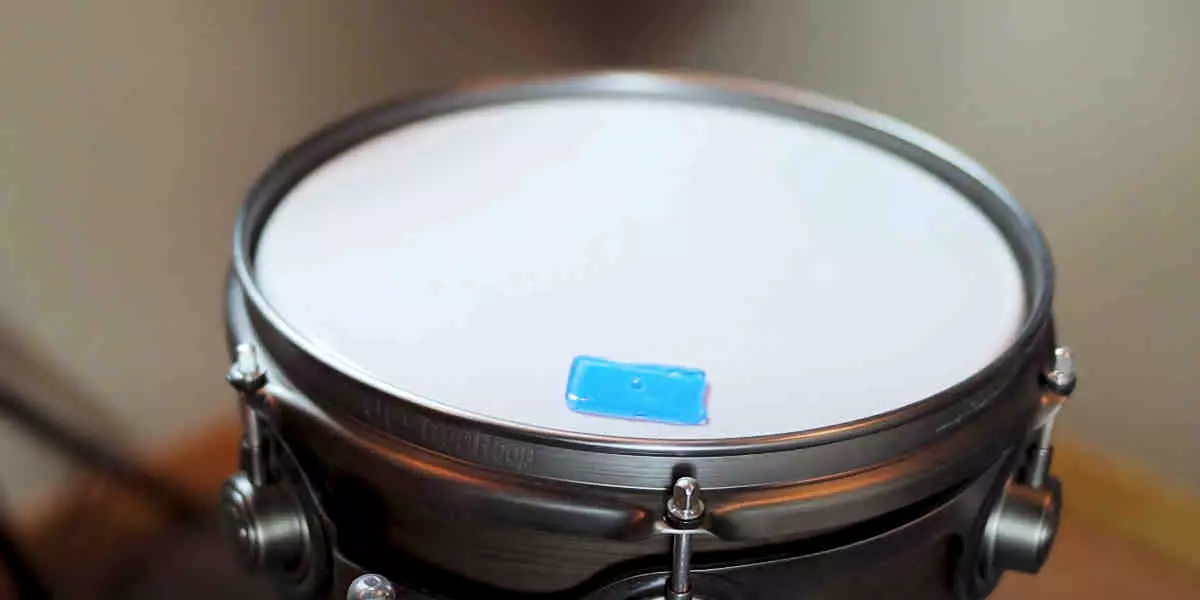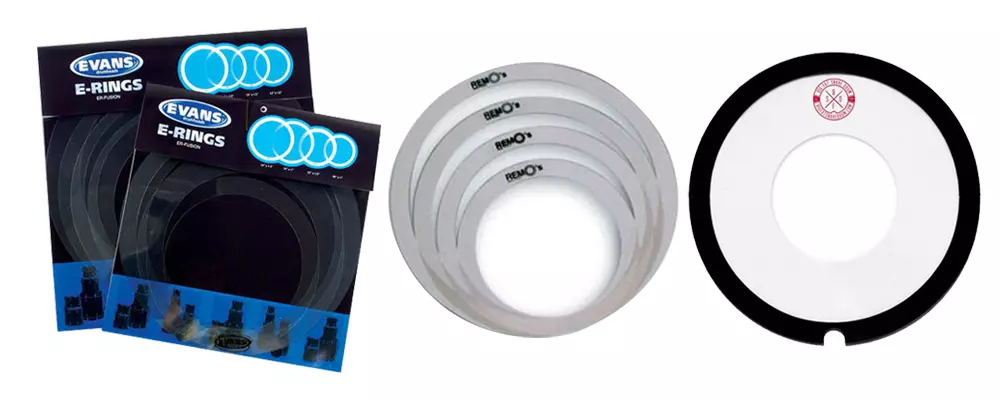Drum Muffling Part 1: Gels and Rings and Tape, Oh MY!

From internal mufflers on vintage drums, to the tea towels on Ringo's toms, to the cutting edge silicone dampeners of today, drummers over the decades have employed countless items to control the sustain and pitch of their instruments.
Modern drum builders seek to provide their customers with maximum amounts of clarity, projection, resonance and tone. This gives today's drummers a lot more control over their sound, allowing them to decide how long (and how loud) a note each drum will produce.
Muffling is used to eliminate unwanted overtones or to focus and/or fatten a drum's sound. This is accomplished by adding weight to the drum head, restricting its vibration, or both.
A strong word of caution here: Unless you are close-miking your drums, dampening and muffling products should be employed sparingly in live situations - unless you are specifically trying to achieve a retro 1970s sound!
A drum that sounds deep, fat, and focused from the drum throne can sound muddy thirty feet away. Be sure to have someone else play your kit at sound-check if you are using rings or tape on your toms.
Generally, drummers should strive to tune their drums evenly and for maximum resonance first, then work from that “wide open” tuning and apply only the amount of dampening necessary to achieve their desired result.
Trying to tune a drum with any sort of muffling in place will be more difficult, so tune before you dampen or muffle the drum.
GELS
The most convenient and flexible products for drum dampening are gels. These small pieces of tacky material can be positioned easily and removed quickly. The most popular are RTOM's Moongels, but there are many more to choose from on the market, and they all work fairly well.
Gels are exceptionally good at eliminating high-pitched overtones or lingering snare buzz from snare drums. Often a single gel 1-2 cm in from the hoop is all that is necessary to eliminate unwanted over-tones.
If you feel the drum requires more dampening, you can either move the gel inwards from the hoop, or place a second gel somewhere else on the periphery of the head. If you find the drum requires more than two or three gels, you may be better served by using rings.
Gels also work well on toms, but you may find that their effect isn't as noticeable on larger drums such as floor toms or drums with two-ply heads.
Most gels on the market are relatively inexpensive and can be washed and re-used. Just be aware that some coloured gels can leave stains on your drum-heads. Also, most have a tendency to collect dust, hair and drum-stick shavings, making new gels necessary for photo and video shoots.
RINGS
Evans' E-rings and Remo's RemOs are very popular. They are easy-to-use, effective, and inexpensive. Simply buy rings that fit your drums, and you have access to focused drum sounds.
A ring adds weight around the outer edge of a drum head. This added weight lowers the overall pitch of the drum. The fact that the ring rests on the head, floating above it and interfering with vibration of the head near the edge of the drum means that the sustain of the drum is greatly reduced.
Rings are perfect for basement and garage rehearsal spaces. Because they lower the pitch of the drums and reduce sustain, drums will sound more focused and clear in small spaces and that will make them seem less loud overall. Shorter, punchier notes also sound better when playing along to tracks through headphones.
However, there is little you can do to moderate their effect. They are either on or off. Evans does offer a variety of widths for certain drum sizes, but ultimately, there is little you can do to customize or dial in the muffling that a ring provides.
Using rings on your kit in a live-playing situation can result in poor definition between your toms, as the drums will be producing fewer of the high and high-mid frequencies that allow the drums to speak clearly. Similarly-sized rack toms with rings can often sound exactly the same from the audience's perspective if you don't have them properly mic'd.
Related to rings are products like the “Big Fat Snare Drum”. The BFSD comes in a number of styles, and covers a majority of the snare head, producing a much lower, fatter and quieter sound from the drum.
TAPE
Tape can be employed a number of different ways to shorten the decay of your drums. Single strips of tape add a tiny amount of weight and thickness to a drum head. A “loop” of tape acts in much the same way as a gel, with the added benefit of sticking on your resonant heads without falling off!
For more control, fold multiple “ridges” into a length of tape.
For maximum dampening, fold a piece of paper towel and cover it with tape, making a “sonic bandage” for your tom.
Be forewarned that most tape will leave messy, sticky residue behind. Gaff tape is the best choice if you want to keep your gear clean!
INTERNAL MUFFLERS
Many vintage drums (and a few “modern vintage” drums) come equipped with internal mufflers. These devices are thick felt or leather pads inside the drum that are attached to an adjustment knob on the outside of the shell. Twisting the knob clockwise moves the pad into the drum head from underneath. These work surprisingly well and allow for a fair amount of flexibility in regards to controlling the batter head. As long as they aren't over-tightened (deforming the batter head and choking the drum), they are an almost ideal tool for dampening drums.
The major reason internal mufflers aren't standard equipment in modern drum sets is that there is a tendency for the hardware to loosen up over time, creating an audible rattling sound. Repairing the rattle requires the drum to be disassembled - something that isn't convenient to do mid-gig or mid-session.
WALLETS AND WEIGHTS
When you are in a pinch, simply tossing your wallet onto the snare drum can provide plenty of dampening. Funk drummers have been doing this since the sixties, and it is a big part of the “Motown/Stax” sound. Of course, many manufacturers have found more elegant ways to add weight to your batter head, and they all work well. Some are even modelled to look like a wallet!
One last quick tip for hard to tame floor toms
Try placing a stretched out cotton ball inside the drum. The cotton will float up during the initial note, but then settle back onto the resonant head, dramatically reducing the sustain and controlling overtones.
You can choose any number of dampening solutions to suit your situation, sound and style. This has been a quick overview of popular tools, but it certainly isn't an exhaustive list of all the things you could use.
Along with head selection and tuning, dampening is one of the most effective tools in a drummer's arsenal to creatively change the sound of their instruments. Experiment and hear how various products and techniques affect your drums.
. . .
Tony Bouma (“Tony B.”) is a drummer, martial artist and painter living in Southwestern Ontario. In his 25-plus years behind the kit, he has backed numerous rock, blues and country acts on local and regional levels. Tony works at Long & McQuade in Cambridge.








